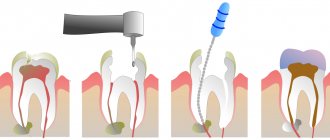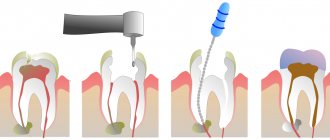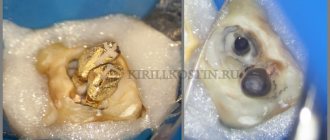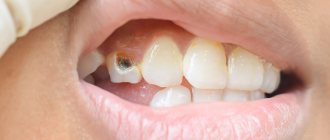Content:
- When is a non-permanent filling indicated?
- Why does a tooth with a temporary filling hurt?
- When to sound the alarm
- What to do if a tooth hurts under a temporary filling
- Preventive measures
Most often, people rush to the dental clinic because of pain.
Naturally, every person hopes that he will return home with a healthy tooth. Unfortunately, this is not always the case. Often in dental practice there are situations when the doctor has to put a temporary filling instead of a permanent one. It is distinguished by its low cost and loose structure. It is loosely held in the carious cavity and quite quickly falls out on its own or decreases in volume. These features are due to the fact that the temporary filling material must be easily removed. The problems it solves:
- protection of the carious “hollow” from the accumulation of food debris and the penetration of pathogenic bacteria;
- preventing premature loss of medication from the “hole”.
Why does a tooth with a temporary filling hurt?
Often the temporary filling hurts. Among the main reasons for this problem are:
- Serious damage to dentin tissue. Injuries to dentinal tissues when treating a carious area with a drill cannot be avoided. Dentin has the ability to heal itself, but this does not happen overnight. Soon everything will return to normal - the patient just needs to be patient.
- Overheating of the dentinal zone. It happens if the doctor worked with the drill for too long and did not use water cooling in the process of cleaning the “hole”. It may also be a consequence of the use of faulty medical equipment.
- The filling height is too high. Then, when pressing on the tooth, acute pain appears. You shouldn't tolerate it. The most reasonable thing is to make an appointment with a doctor and ask him to remove the excess material. In general, this reason is rare, since before sending the patient home, a good specialist always makes sure that the material is standing properly and does not take up excessive space.
- Exceeding the prescribed treatment period. The doctor clearly announces when you need to come for a follow-up appointment to remove the stored medicine. But some people ignore such instructions and walk with the material longer. Then there is a destructive effect on the tissues of the unit, aching or acute pain appears. A medicinal composition whose service life has long expired becomes toxic. It disrupts metabolic processes occurring in local tissues. Promotes crown destruction. Cracks form on the surface of the latter.
- Individual intolerance to the prescribed filling composition. Sometimes in dental practice there are allergies to the drugs used. Then, after laying the material, swelling appears. The tooth starts to hurt.
- Partial destruction of the seal. The formed depression may be very small and, quite possibly, the person will not even notice that any changes have occurred to his tooth. Meanwhile, pathogenic organisms will begin to penetrate through the hole that appears into the deep tissues. This will cause inflammation. The unit will begin to react painfully to temperature changes, spicy, salty and sour foods.
It is important to understand what is causing the pain symptoms. The patient cannot do this on his own, since this involves an in-person examination in the dentist’s office. You need to make an appointment with a doctor as soon as possible and undergo the treatment he suggests.
Life time
The service life of a temporary filling varies from 3-4 days to 2-3 weeks. The exact timing depends on the specific dental disease and the drugs used in treatment.
Here's how much a temporary filling can cost in different situations:
- when using arsenic paste to kill a diseased nerve - no more than 2-3 days (usually 24-28 hours), when using other means (for example, paraform paste) for the same purposes - 5-10 days;
- when using antibiotics and antiseptics in the treatment of deep caries or pulpitis - from 3-4 days to 2-3 weeks;
- in particularly complex diagnostic cases – up to 3 and even 6 months.
If you can’t get to the doctor on time, be sure to notify him in advance. In this case, if possible, he will try to place the most durable reflective filling that can be safely worn for several months.
When to sound the alarm
Is it normal for a tooth with a temporary filling to hurt a lot? No. Mild discomfort is possible, but long-lasting acute pain is a reason to visit the doctor again. However, this should be done as soon as possible. It is especially dangerous if a person’s well-being worsens at night, swelling has formed or a purulent “bump” has appeared - all this may indicate the rapid progression of dangerous complications.
What kind of pain can there be and what problem does it indicate:
- The tooth aches constantly. The state of health after the last visit to the dentist does not worsen, but does not improve either. This is possible if you are allergic to a dental composition, use too high a dose of the drug (intoxication occurred due to an overdose), or use a very low dose of the drug (the infection could not be stopped and it continues to actively progress).
- Discomfort appears only when pressing on the diseased unit. Here one should suspect traumatic damage to the periodontium due to the artificial overestimation of the dental crown.
- Unbearable pain appears even with a slight touch to the tooth. Perhaps a fragment of a medical instrument remains in the canal or acute periodontitis has developed.
- There are attacks of pain. This happens when the purulent form of pulpitis is advanced.
Basic rules of oral hygiene after tooth extraction
In order to prevent possible complications after the procedure, you need to strictly follow the rules of oral hygiene.
- Two to three days after tooth extraction, the mouth can be rinsed with a soda solution. It is diluted in the ratio of one teaspoon of soda to one glass of warm water. You can also rinse with other means that help faster healing, for example, Chlorhexidine. Rinsing should be done very carefully, as it can damage the integrity of the blood clot that has formed in the hole. Gentle rinsing is carried out by drawing a solution into the oral cavity. After this, you just need to hold the solution in your mouth for a while and then spit it out. This rinse will not harm the blood clot.
- Rinsing is necessary to prevent infection or food particles from entering the wound, which can cause suppuration.
You can gently rinse your mouth with Chlorhexidine
There are a number of symptoms that indicate the presence of complications in the postoperative period. Among them:
- pain that does not subside for several days after the procedure. In the presence of such pain, even various painkillers cannot help;
- the patient notes continuous bleeding from the wound. In this case, the blood has a bright scarlet hue;
- The patient’s body temperature rises and remains for 24 hours after the tooth extraction procedure;
- slight swelling of the cheek after the procedure develops into severe swelling that spreads over the entire side of the face. The patient feels weak and drowsy;
- pus is leaking from the wound or the area around the wound has begun to darken. In this case, after a few days the patient experiences a persistent putrid odor from the mouth;
- the dentition may become mobile;
- divergence of applied sutures.
Complications may occur after tooth extraction
Important ! If the patient notices any of the listed symptoms, in this case it is necessary to urgently consult a doctor. If such complications are left unattended, they will soon develop into more serious pathologies that can threaten not only the patient’s health, but also his life.
Video: How to care for your mouth after tooth extraction?
What to do if a tooth hurts under a temporary filling
The first thing a patient should do is get qualified medical care. Remember: for acute pain, all dentists accept appointments without an appointment. If for some reason a visit to the dentist has to be postponed for one or two days (for example, discomfort occurred on the weekend), you will have to self-medicate. This may include:
- Taking a safe analgesic. It is advisable to consult with your dentist in advance about acceptable medications that reduce pain symptoms. Such drugs should always be selected on an individual basis, as they have a large number of side effects and contraindications.
- Rinsing the mouth with a solution of salt or soda. Decoctions of chamomile and sage have proven themselves well. It is also acceptable to periodically apply an anesthetic dental gel to the gums.
It is possible that after the examination the specialist will say that there is no cause for concern. Then the patient will have to complete the prescribed period, relieving pain with analgesics.
Under no circumstances should you force the process of replacing a temporary filling material with a permanent one. This can lead to serious complications in the future. Then you will have to unseal and carry out treatment from the very beginning.
Preventive measures
In order for the process of preparing for the main treatment to proceed without unpleasant surprises and dangerous complications, you must follow simple rules:
- Try not to put stress on the sealed unit. This means that you should chew food from the “healthy side”. Under no circumstances should you chew on foreign objects. Also, intensive rinsing should not be done unless prescribed by a doctor.
- Maintain good oral hygiene. It is necessary to carry out hygiene measures in the morning and evening. Inflamed areas of the gums can be treated with a brush with soft bristles.
- Check the temporary filling for cracks and chips. If they appear, a re-sealing should be carried out. Otherwise, by the time the permanent material is installed, there may be nothing left of the dental crown - it will collapse under the aggressive influence of pathogens.
Watch your tooth filled with a temporary filling carefully. Then you will avoid many problems.
How long does it take for treatment?
How long does it take to treat the disease to get a positive result from therapy? In this situation, everything will depend on many factors. First of all, attention is paid to the stage of the disease and the inflammatory process. The general condition of the patient and other severe symptoms must also be taken into account. Do not forget about the destructive process and the possibility of restoring a damaged tooth.
If it is possible to leave the pulp and not remove the tooth, then a conservative treatment method is used, which includes several visits to the dental office. If a patient is diagnosed with an advanced stage of pulpitis, it is recommended to undergo surgical treatment, which also involves several visits to a specialist.
Why do they place a temporary filling for pulpitis?
Temporary filling is recommended for conservative treatment of pulpitis and caries. It is installed in order to prevent the leakage of the anti-inflammatory drug from the root canal, as well as to prevent the entry of pathogenic microflora and pieces of food.
What medicine is put into the tooth for pulpitis?
It is impossible to treat tooth pulpitis without the use of various drugs. The medicine is placed under the filling to eliminate the infection and inflammatory process.
Various anti-inflammatory drugs may be used. Very often, arsenic is placed in the tooth to kill the nerve and numb the problem area.
Types of temporary fillings
You cannot do without a temporary filling in the following cases:
- For conservative treatment of not too advanced pulpitis and advanced caries. After drilling out the inflammatory focus and treating the root canals, the tooth cavity is filled with anti-inflammatory drugs, and a filling is placed on top. This is necessary so that the drug does not leak out and that microbes and pieces of food do not get into the diseased tooth.
- For diagnosis in deep caries, when it is unclear whether the nerve is affected. They put a filling with medicine and watch the tooth - if it continues to hurt, most likely it is pulpitis.
- In the treatment of pulpitis, if there is a need to remove the nerve. Then the treatment is carried out in 2 steps: first, a filling is placed with arsenic or other, more gentle devitalizing drugs, and after the death of the nerve, treatment is carried out.
- For prosthetics and restoration to protect teeth while permanent structures are being made.
Installing a temporary filling is absolutely safe, except in cases where individual allergic reactions to filling materials are observed.








